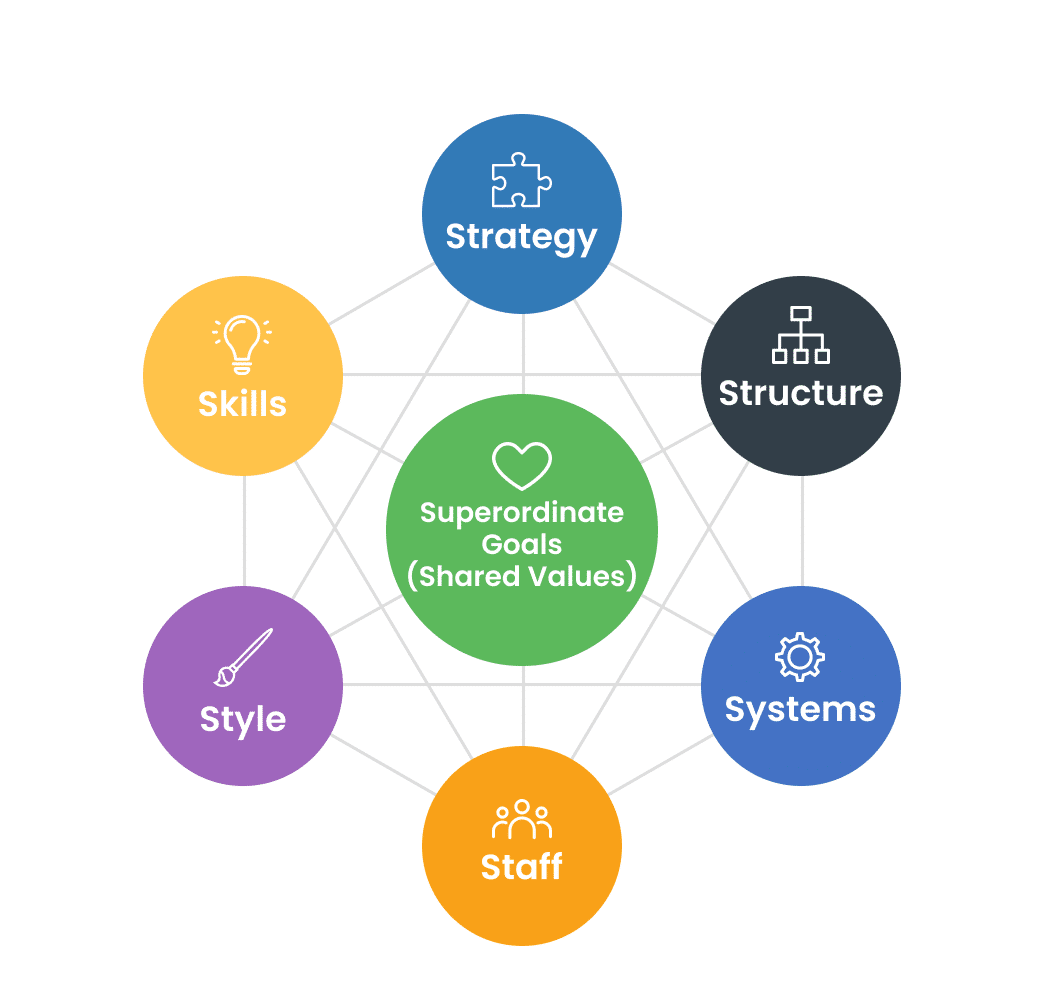What if every member of your team was not just working, but actively contributing to your company’s biggest goals? When your strategic vision is disconnected from your teams’ daily work, progress doesn’t just slow down—it grinds to a halt. It’s like having a detailed roadmap but sending your drivers in different directions. This common disconnect between long-term goals and daily tasks leads to wasted effort and missed opportunities. But what if you could bridge that gap? This article explores how to achieve organizational alignment, turning your strategic vision into actionable, coordinated work. We’ll show you how a system like KPI Fire can make this possible, linking your high-level objectives to team projects and KPIs in one seamless flow, ensuring everyone is moving toward the same destination.
What is Organizational Alignment and Why Does It Matter?
Organizational alignment is the practice of ensuring every component of a company—from its overarching strategy to the daily tasks of an individual employee—is harmonized and working toward the same ultimate goals. Think of it as the gravitational force that keeps all the moving parts of an organization in their proper orbit, preventing them from flying off in different directions.
This concept is more than just a theoretical framework; it’s a fundamental driver of business vitality. When an organization is truly aligned, it reaps tangible benefits, including:
Enhanced Performance and Productivity
With a clear line of sight between their work and company objectives, employees can make smarter decisions and prioritize tasks that truly matter. This focused effort eliminates wasted energy and significantly boosts overall productivity.
Greater Employee Engagement
When team members understand how their contributions fit into the larger picture, their sense of purpose and value skyrockets. This feeling of significance directly translates to greater employee engagement; higher morale, stronger loyalty, and a more motivated workforce.
Increased Agility and Adaptability
An aligned organization is more flexible. When priorities are clear and shared, teams can quickly adjust to market shifts or new opportunities without internal friction, allowing the company to pivot with speed and confidence.
Stronger Collaboration
Alignment dissolves departmental silos and boosts cross-functional collaboration. When teams see how their work impacts others, they’re more likely to communicate effectively and cooperate, turning a group of independent units into a truly cohesive team.
In essence, organizational alignment is what transforms a company from a collection of individuals into a powerful, unified force, capable of executing its strategy with precision and achieving its vision.
The High Cost of Disconnected Strategy
A brilliant strategy is a roadmap to success, but without proper execution, it’s just a document on a shelf. When a company’s strategic plan fails to cascade down to the daily activities of its teams, the consequences are far more costly than most realize. This invisible disconnect acts as a slow leak, draining your organization of its potential, energy, and resources.
The high cost of a misaligned strategy manifests in several critical areas:
Wasted Time and Resources
When teams don’t understand the strategic priorities, they’re left to guess. This often results in a flurry of activity—projects and tasks that feel important but don’t actually move the company closer to its goals. This “busyness” is a deceptive form of inefficiency, burning through time, budget, and employee energy without yielding meaningful results. Learn how to set clear team goals to avoid the 8 wastes.
Organizational Gridlock
A lack of strategic alignment forces teams to operate in silos. Departments may develop their own, often competing, priorities, leading to internal friction, endless meetings to resolve conflicts, and a slow, cumbersome decision-making process. This gridlock makes your company slow to react to new market opportunities and challenges.
Employee Disengagement
When the connection between an employee’s daily work and the company’s long-term vision is missing, their sense of purpose erodes. They may begin to feel like a cog in a machine, leading to decreased motivation, lower morale, and a higher risk of turnover. Talented employees are often the first to leave, seeking roles where their contributions feel more significant.
The Breakdown of Collaboration
A disconnected strategy creates a “my department first” mentality. Without a shared, unifying objective, teams may withhold information, duplicate efforts, and fail to support cross-functional initiatives. This breakdown in collaboration stunts innovation and prevents your organization from tackling complex problems that require a unified approach.
Ultimately, a disconnected strategy is a silent inhibitor of growth. It prevents your company from performing as a cohesive unit, allowing valuable resources to be misspent, talent to become disengaged, and potential to remain untapped.
How to Build a Culture of Alignment: From Vision to Action
Building a culture of alignment is not a project with a start and end date; it’s an ongoing process that becomes an integral part of your company’s DNA. It requires a conscious effort to move beyond simply creating a strategy and toward embedding that strategy into every aspect of your organization’s daily life. Here is a blueprint for cultivating a culture where vision and action are one and the same.
1. Anchor Your Strategy in a Compelling “Why”
Your company’s strategy is far more powerful when it’s rooted in a purpose that resonates with everyone. Don’t just present a list of goals; share the narrative behind them. To do this, we can apply the “5 Whys” technique to a hypothetical company’s strategy. This method helps to dig deeper into the root cause or, in this case, the ultimate purpose behind the stated goals. Explain the company’s ultimate mission and how these goals are the critical steps to achieving it. This emotional connection transforms employees from passive executors into passionate stakeholders, making them more invested in the journey and the destination.
2. Create a Straight Line of Sight from Top to Bottom
For alignment to work, every employee needs to see how their daily tasks contribute to the company’s grand plan. This requires a cascading process where the top-level strategic objectives are broken down into measurable, actionable goals for each department, team, and individual. When every person can trace their own work directly back to a strategic objective, the organization becomes a well-oiled machine where every action serves a purpose.
3. Empower Teams to Own the How
While the strategic goals should be non-negotiable, the path to achieving them doesn’t have to be dictated from the top. Empower your teams by giving them the autonomy to develop their own projects and initiatives that support the broader objectives. This ownership fuels innovation, increases accountability in teams, and ensures that the best ideas—no matter where they come from—have a chance to flourish.
4. Measure Progress and Celebrate Wins
What gets measured gets managed. To keep alignment strong, you need to establish clear, trackable metrics for growth at every level. Regularly review these metrics in team meetings and company updates. Make sure to publicly recognize and celebrate operational excellence milestones and achievements. This not only reinforces the importance of the strategic goals but also validates the hard work of the people who are making them happen.
5. Lead with Purpose and Clarity
A culture of alignment is built on trust, and that trust starts with leadership. Leaders must consistently “walk the talk” by making decisions that are transparently linked to the strategic vision. When leaders openly communicate, own their mistakes, and hold themselves accountable to the same standards, they create an environment where alignment can thrive organically.
The Role of Technology in Syncing Strategy and Teams
While a strong culture and clear communication are the foundation of alignment, technology is the engine that transforms those concepts into a functional system. In a world moving faster than ever, relying on spreadsheets, emails, and disconnected documents to manage your strategy is a recipe for disaster. A purpose-built platform is the essential tool for bridging the gap between your grand vision and the daily work that makes it a reality.
Here’s how the right technology supercharges your organization’s ability to align:
A Unified Source of Truth
The right system consolidates your entire strategic plan into a single source of truth. This means everyone, from the CEO to a front-line team member, can access the same up-to-date information on objectives, projects, and key metrics. This transparency eliminates confusion, builds trust, and ensures that every decision is informed by a complete and accurate picture of progress.=
Real-time Visibility
Instead of waiting for a monthly report, technology provides instant, real-time insights into what’s working and what’s not. Executive dashboards for KPI management and automated updates allow leaders to quickly identify potential bottlenecks or off-track initiatives. This proactive approach lets you make swift course corrections, keeping your organization nimble and preventing minor issues from derailing major goals.
Clear Connection to Impact
The most effective alignment tools don’t just track work; they link it directly to your strategic goals. When an employee updates a project, they can see exactly how that progress impacts a department-level KPI and, in turn, a company-wide objective. This tangible connection to impact is a powerful motivator that gives employees a sense of purpose and ownership.
Streamlined Communication
Technology provides a structured channel for conversations about goals and performance. It moves these discussions out of fragmented email chains and into a focused platform where updates, feedback, and collaboration are centered around shared objectives and/or team goals. This promotes better teamwork and breaks down the communication barriers that often lead to silos.
Where efficiency and agility are paramount, a purpose-built system isn’t just a convenience—it’s a fundamental necessity for any organization committed to syncing its strategy and teams for sustained, predictable success.
The 7-S Model of Organizational Alignment
The McKinsey 7-S Model is a widely used strategic framework that helps organizations analyze and manage change by looking at the interconnectedness of seven internal elements. The core idea is that for an organization to be effective, these seven “S’s” must be aligned and mutually reinforcing.
The model divides the seven elements into two groups: “hard” elements, which are easier to identify and influence, and “soft” elements, which are more intangible and rooted in the company’s culture.
The Hard Elements:
- Strategy: The plan an organization has to achieve its goals and gain a competitive advantage. It’s the “what” and the “how” of the business’s direction.
- Structure: The organizational chart and hierarchy—how the company is organized, who reports to whom, and how departments are divided and coordinated.
- Systems: The formal and informal processes, procedures, and information flows that govern the daily operations of the company. This includes everything from IT systems and financial processes to hiring and performance evaluation procedures.
The Soft Elements:
- Shared Values: These are the company’s core beliefs and guiding principles. Often placed at the center of the model, shared values are the cultural glue that holds the organization together and influences all other elements.
- Skills: The capabilities and competencies of the organization as a whole, as well as the individual skills of its employees.
- Style: The leadership style and management approach of the company’s key groups. This includes how leaders interact with employees and how they influence the corporate culture.
- Staff: The people within the organization—their demographic characteristics, training, and how they are hired, developed, and motivated.
The 7-S model is a powerful tool for diagnosing misalignment. If a company’s strategy changes (a hard element), the model suggests that the other six elements—including the soft ones like skills and culture—must also be considered and potentially adjusted to maintain a state of alignment and ensure the new strategy is successfully executed. It emphasizes that a change in one area will inevitably have a ripple effect on the others, and ignoring these interdependencies is a common reason for strategic initiatives to fail.

KPI Fire: Your Solution for Seamless Alignment
A great strategy needs a great system for execution. That’s where a solution like KPI Fire comes into play, transforming the abstract concept of organizational alignment into a practical, day-to-day reality.
KPI Fire is a comprehensive platform designed to bridge the chasm between your high-level plans and the daily grind of your teams. It acts as a central nervous system for your business, ensuring that every project, every metric, and every person is connected and contributing to a shared purpose.
Here’s how KPI Fire helps you achieve true, seamless alignment:
- Creates a Unified Strategic View: With KPI Fire, your entire strategic plan is housed in one place. You can define your long-term objectives and then break them down into measurable goals for each department and team. This gives everyone a crystal-clear “line of sight,” so they can see how their work ladders up to the company’s ultimate success.
- Links Work to Impact: The platform is built to connect projects directly to the KPIs that matter most. This isn’t just about managing tasks; it’s about making sure every initiative is tied to a specific, measurable outcome. When teams can see how their work directly impacts the numbers that drive the business, their sense of purpose and accountability skyrockets.
- Provides Dynamic Transparency: Say goodbye to outdated reports and siloed information. KPI Fire offers real-time dashboards that provide an instant snapshot of your organization’s progress. Leaders can quickly identify areas that are on track or falling behind, enabling them to make proactive adjustments before small issues become major problems. This transparency fosters a culture of trust and shared responsibility.
- Empowers Continuous Improvement: Beyond alignment, the platform is built to facilitate a culture of ongoing growth. It provides tools to manage improvement initiatives, track the value of process changes, and foster a cycle of learning. This empowers teams not just to execute the strategy, but to continuously refine and optimize the way they work.
Stop managing strategy in spreadsheets and presentations. It’s time to make execution your competitive advantage. Start your journey to all-round execution by requesting a demo of KPI Fire now.




